Jerusalem Artichoke, Jerusalem Sunflower, Sunchoke, Girasole - Helianthus tuberosus
|
Helianthus tuberosus - Jerusalem Artichoke, Jerusalem Sunflower, Sunchoke, Girasole. As with many members of Helianthus, Jerusalem Artichoke can be quite variable. One of the key features of this plant, the edible tubers, are underground and produced late in the season, so they aren't really a good identification feature (unless you want folks walking around pulling up the plants - I don't.)
This beautiful, showy sunflower is considered weedy or invasive by some authorities. It is found in all but 5 states, and also in much of Canada.
Found in:
AL, AR, CA, CO, CT, DC, DE, FL, GA, IA, ID, IL, IN, KS, KY, LA, MA, MD, ME, MI, MN, MO, MS, MT, NC, ND, NE, NH, NJ, NY, OH, OK, OR, PA, RI, SC, SD, TN, TX, UT, VA, VT, WA, WI, WV, WY
Leave comments on Helianthus tuberosus at this link. | 
Distribution of Helianthus tuberosus in the United States and Canada:

Map courtesy of The Biota of North America Program.
Map color key
Search Our Database: Enter any portion of the Scientific, Common Name, or both.
Do a general Google search of the entire site:
#ad
 Follow USWildflowers on Twitter
#ad
| | Site: Walker County, GA Date: 2012-October-04 | Photographer: Gerald C Williamson
Nikon D7000
Tamron SP 90MM f/2.8 AF Macro
| | The bright yellow blossom of Jerusalem Artichoke will have 10 to 20 ray flowers each up to about an inch and a half long. The yellow disk is typically up to an inch across. | | 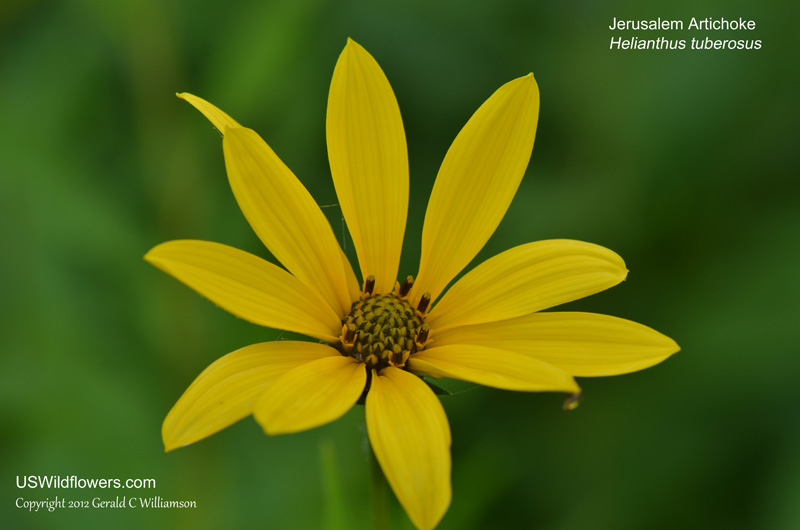
| | Site: Walker County, GA Date: 2011-September-24 | Photographer: Gerald C. Williamson
Nikon D7000
| | The bright yellow blossom of Jerusalem Artichoke will have 10 to 20 ray flowers each up to about an inch and a half long. The yellow disk is typically up to an inch across. | | Click on the photo for a larger image
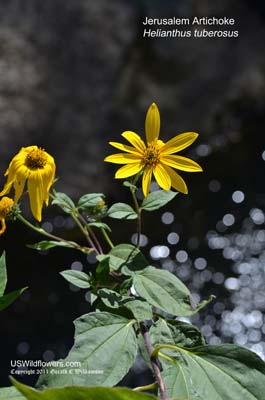
| | Site: Walker County, GA Date: 2011-September-24 | Photographer: Gerald C Williamson
Nikon D7000
Tamron SP 90MM f/2.8 AF Macro | | Jerusalem Artichoke can be up to 10 feet tall, with one to several stems terminated with a cluster of one or more blossoms. The plants will frequently grow in large sprawling colonies in moist areas. The colonies I've seen have been in open areas near creeks. | | Click on the photo for a larger image
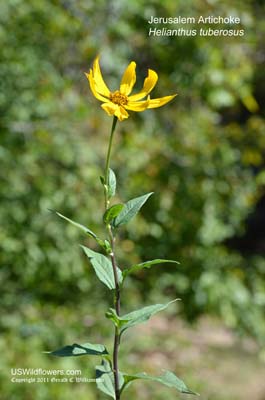
| | Site: Walker County, GA Date: 2011-September-24 | Photographer: Gerald C Williamson
Nikon D7000 | | As with many members of Helianthus, H. tuberosus will likely have both opposite and, in the upper part of the plant, alternate leaves. | | Click on the photo for a larger image
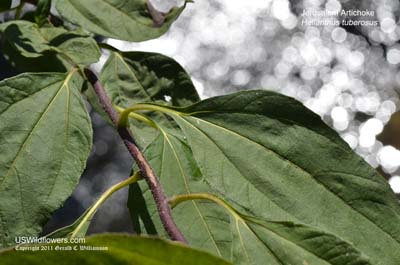
| | Site: Walker County, GA Date: 2011-September-24 | Photographer: Gerald C Williamson
Nikon D7000
Tamron SP 90MM f/2.8 AF Macro | | The lower leaves of Jerusalem Artichoke will be opposite. The leaves are rough, ovate (widest part closer to the stem), and on winged petioles. Some of the leaves (particularly upper ones) may be lanceolate rather than ovate, but generally the leaves will be broader than the somewhat simlar H. giganteus. The leaves can be up to 8 to 10 inches long. The stems are hairy to one degree or another, and can be reddish. Similar H. grosseseratus has smooth, usually glaucous reddish stems. | | Click on the photo for a larger image
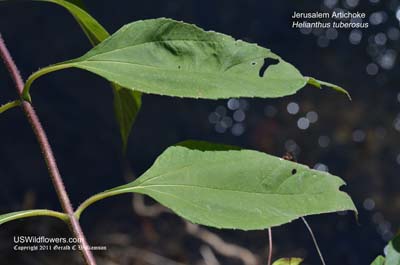
| | Site: Walker County, GA Date: 2011-September-24 | Photographer: Gerald C Williamson
Nikon D7000
Tamron SP 90MM f/2.8 AF Macro | | The hemispheric involucres will have up to 35 lanceolate, sharp-tipped, dark green phyllaries which have ciliate edges. Most will be black as they dry. | | Click on the photo for a larger image

| | Site: Walker County, GA Date: 2012-October-04 | Photographer: Gerald C Williamson
Nikon D7000 | | Jerusalem Artichoke grows in large colonies. | | Click on the photo for a larger image
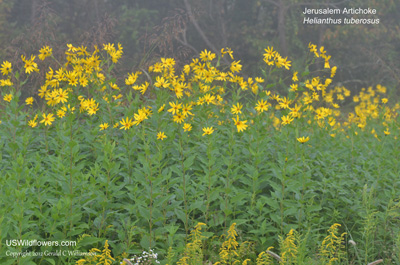
|
References used for identification and information:
|
|
| |
| #ad
|
|









